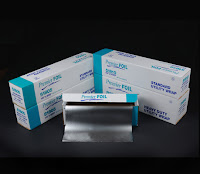What is the difference between Deli Wrap, Wax Paper or Parchment Paper?
Most people know the difference between foil and wax paper but do you know the difference between Deli Paper, Wax Paper or Parchment Paper? These papers have a variety of different uses. Packaging your food properly preserves freshness and ensures safe handling. So we have put together some tips on how to choose the right paper and how to use them.
Wax Paper vs. Parchment Paper
 Wax Paper and Parchment Papers are both coated. The difference between them is that Wax Paper is coated with a soybean or paraffin wax and Parchment Paper (available in bleached or unbleached) is coated with silicone.
Wax Paper and Parchment Papers are both coated. The difference between them is that Wax Paper is coated with a soybean or paraffin wax and Parchment Paper (available in bleached or unbleached) is coated with silicone.The silicone coating in Parchment Paper makes it heat resistant and nonstick. So this makes a perfect liner for baking pans since the food won't stick to the pan. Wax paper would melt and stick to the pan.
Wax paper is best used to line counter tops and tables when rolling out pies or kneading bread to prevent a mess. Wax paper is also used to wrap food for cold storage such as hamburgers or brownies since this will prevent them from sticking.
So wax paper is good for cold and parchment paper is good for hot. Parchment paper can also be used over and over again while wax paper can not.
Parchment paper can be used in most applications that call for wax paper as a non-stick surface. The reverse is not true, as using wax paper will cause smoke in the oven and affect taste.
Wax Paper Fast Facts
1. Coated with soybean wax or paraffin - moisture resistant. Moisture resistance prevents food from getting soggy.2. Not for oven use
3. Single use
Uses for Wax Paper: wrap cold foods such as hamburgers, lining pizza boxes, candy dipping, kneading breads
Foil vs. Parchment Paper
Foil is a staple in most kitchens. Many people use it to line cooking dishes for easier cleanup. Its most popular use is capping hot dishes or wrapping your favorite dessert. However, it doesn't provide nonstick properties, unlike parchment paper. Pieces of foil could end up stuck to the bottom of your roasted vegetables or cookies. Also, research has found (International Journal of Electrochemical Science http://www.electrochemsci.org/papers/vol7/7054498.pdf) that small amounts of aluminum could leak into food while cooking.
Also, research has found (International Journal of Electrochemical Science http://www.electrochemsci.org/papers/vol7/7054498.pdf) that small amounts of aluminum could leak into food while cooking.So in choosing whether to grab foil or parchment paper a good rule of thumb is to remember that if you don't want it to stick use parchment paper and if you want to insulate, use foil.
Many wonder if it makes a difference which side of the aluminum foil you use. Actually there is no difference both sides do the same fine job of cooking, freezing and storing food. The difference in appearance between dull and shiny is due to the foil manufacturing process.
Uses for Foil: wrap sandwiches, wrap meat for short-term freezing, cover bowls to hold in heat and make disposable funnels.
Parchment Paper Fast Facts
1. Coated with silicone or quilon - nonstick - heat resistant.2. Oven safe
3. Reusable
Uses for Parchment Paper: line pans during baking, wrap sandwiches.
If you would like additional information on any food wrap please feel free to contact Mansfield Paper Company at www.mansfieldpaper.com. We have 70 years experience in assisting people with the best product for their needs.




